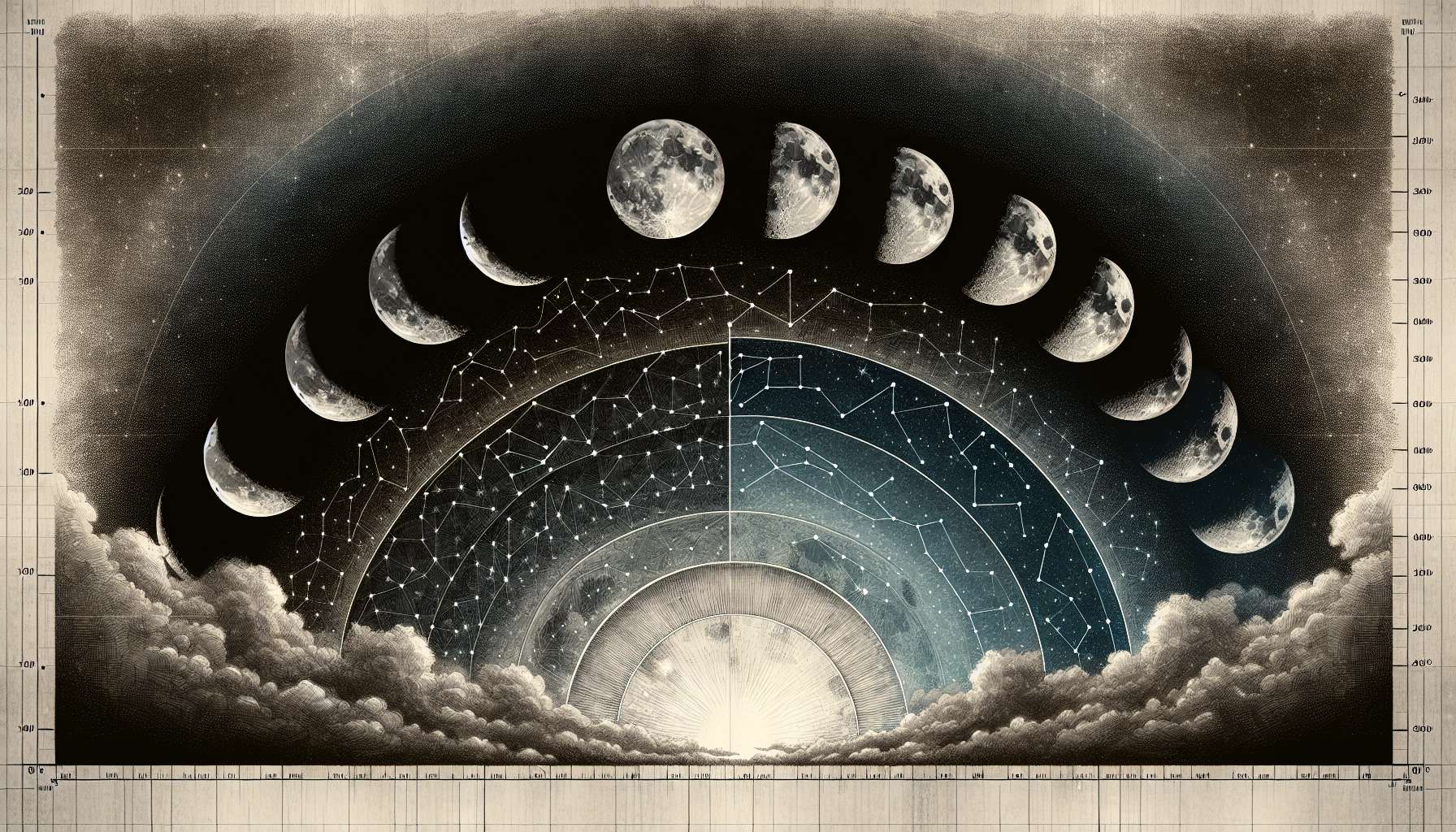Lunar Phase Studies: Exploring the Mysteries of the Moon
Have you ever gazed up at the night sky and marveled at the ever-changing shape of the moon? The moon has captivated humans for centuries, inspiring art, poetry, and scientific inquiry. One fascinating area of study related to the moon is lunar phase studies. This field delves into the various phases of the moon, their effects on nature, human behavior, and even agriculture. Join us on a journey as we unravel the mysteries of lunar phase studies and explore the profound impact of the moon on our world.
The Science Behind Lunar Phases
Before we delve into the intricacies of lunar phase studies, let’s first understand the science behind the moon’s phases. The moon orbits around the Earth, and as it does so, different portions of its illuminated half are visible from our planet. This phenomenon results in the changing appearance of the moon, known as lunar phases. The four primary lunar phases are the new moon, first quarter, full moon, and last quarter.
During a new moon, the side of the moon facing Earth is not illuminated by the sun, making it appear dark in the night sky. As the moon progresses through its orbit, it reaches the first quarter phase, where half of the moon is illuminated. The full moon occurs when the entire illuminated half of the moon is visible from Earth, while the last quarter phase shows half of the moon’s illuminated side.
Understanding the science behind lunar phases is crucial to unraveling their impact on various aspects of our lives. From ancient civilizations to modern-day researchers, the moon’s phases have been a source of fascination and study.
The Historical Significance of Lunar Phase Studies
Throughout history, humans have been deeply connected to the moon, attributing mystical powers and significance to its phases. Ancient cultures such as the Egyptians, Greeks, and Mayans observed the moon’s cycles and incorporated them into their religious beliefs and rituals. The lunar calendar, based on the moon’s phases, played a vital role in determining agricultural activities, religious ceremonies, and even governance.
One of the most famous examples of the historical significance of lunar phase studies is the creation of the lunar calendar by the ancient Babylonians. This calendar, based on the moon’s phases, consisted of 12 lunar months, each corresponding to a specific phase of the moon. The Babylonians used this calendar to track time, plan religious festivals, and regulate agricultural practices.
As civilizations progressed, the study of lunar phases evolved, leading to the development of lunar calendars in various cultures around the world. The Mayans, for instance, created a complex calendar system that integrated lunar phases with celestial events and agricultural cycles. The Mayan calendar, known for its precision and accuracy, is a testament to the profound understanding of lunar phase studies in ancient times.
The Modern Applications of Lunar Phase Studies
While lunar phase studies have a rich historical background, their relevance extends far beyond ancient civilizations. In the modern era, researchers and scientists are exploring the practical applications of lunar phases in various fields, including agriculture, medicine, and even finance.
Agriculture
One of the most significant applications of lunar phase studies is in agriculture. Farmers have long observed the moon’s phases to determine the best times for planting, harvesting, and even pruning crops. The lunar calendar, based on the moon’s phases, provides valuable insights into the optimal timing of agricultural activities.
According to lunar phase studies, planting crops during specific lunar phases can enhance their growth and yield. For example, planting root crops during the new moon or first quarter phase is believed to promote healthy root development, while sowing above-ground crops during the full moon or last quarter phase may result in better harvests.
In addition to planting, lunar phase studies also suggest that pruning trees and bushes during specific lunar phases can improve their growth and fruit production. By aligning agricultural practices with the moon’s phases, farmers can optimize their crop yields and minimize the use of pesticides and fertilizers.
Medicine
Another intriguing application of lunar phase studies is in the field of medicine. While the connection between lunar phases and human health may seem esoteric, some researchers believe that the moon’s cycles can influence our well-being. Lunar phase studies suggest that certain medical procedures, such as surgery and dental work, may be more successful when performed during specific lunar phases.
For example, some studies indicate that surgeries conducted during the waxing moon (from new moon to full moon) have a higher success rate and lower complication rates. This phenomenon is attributed to the moon’s gravitational pull, which is believed to affect blood flow, wound healing, and overall recovery after surgery.
While the scientific basis for these claims is still debated, the idea of lunar phase studies influencing medical practices is gaining traction in some circles. As researchers continue to explore the potential impact of lunar phases on human health, the field of lunar phase studies in medicine is ripe for further investigation.
Finance
Believe it or not, lunar phase studies have even found their way into the world of finance. Some investors and traders use lunar cycles to predict stock market trends, commodity prices, and economic indicators. The premise behind this practice is that the moon’s phases can influence human behavior, market psychology, and decision-making processes.
According to lunar phase studies in finance, certain lunar phases may coincide with market volatility, price fluctuations, or major economic events. By analyzing historical data and lunar cycles, some traders claim to have identified patterns and trends that can help them make informed investment decisions.
While the idea of using lunar phases to predict financial markets may seem far-fetched, some proponents argue that there is a correlation between lunar cycles and market behavior. Whether this correlation is based on scientific evidence or simply coincidence remains a topic of debate in the field of lunar phase studies in finance.
Controversies and Debates in Lunar Phase Studies
As with any scientific field, lunar phase studies are not without controversies and debates. While some researchers tout the benefits of aligning human activities with lunar phases, others remain skeptical of the validity and reliability of such claims. The lack of robust empirical evidence and standardized methodologies in lunar phase studies has fueled skepticism among the scientific community.
One of the primary criticisms of lunar phase studies is the presence of confirmation bias, where researchers selectively interpret data to support preconceived beliefs about lunar influences. The subjective nature of lunar phase interpretations and the lack of controlled experiments make it challenging to establish causal relationships between lunar phases and human behavior.
Despite these challenges, proponents of lunar phase studies argue that the historical and cultural significance of the moon cannot be ignored. The moon has inspired awe, wonder, and curiosity in humans for millennia, shaping our beliefs, traditions, and rituals. While the scientific basis for lunar phase studies may be limited, the emotional and psychological impact of the moon on human culture is undeniable.
Expert Opinions on Lunar Phase Studies
Leading researchers and experts in the field of lunar phase studies offer a range of perspectives on the topic. Some scientists emphasize the need for rigorous scientific inquiry and empirical evidence to support claims about lunar influences, while others highlight the cultural and historical importance of the moon in human society.
Dr. Sarah Johnson, a renowned astronomer and lunar researcher, believes that while the moon’s phases have cultural significance, their impact on human behavior and natural phenomena may be overstated. Dr. Johnson advocates for a more nuanced and evidence-based approach to lunar phase studies, encouraging researchers to conduct controlled experiments and data analysis to validate their claims.
In contrast, Dr. Thomas Lee, a psychologist specializing in lunar psychology, argues that the moon’s phases can influence human emotions, behavior, and cognitive processes. Dr. Lee points to research studies that suggest a correlation between lunar phases and mood disorders, sleep patterns, and even criminal behavior. While the mechanisms underlying these effects remain unclear, Dr. Lee believes that lunar phase studies offer valuable insights into the human psyche.
Common Misconceptions about Lunar Phase Studies
One common misconception about lunar phase studies is the idea that the moon’s phases directly cause changes in human behavior or natural events. While some studies suggest correlations between lunar phases and certain phenomena, causation has not been definitively established. The complex interplay of factors influencing human behavior and natural processes makes it challenging to isolate the specific effects of lunar phases.
Another misconception is that lunar phase studies are purely pseudoscience or mystical beliefs with no basis in empirical evidence. While the scientific rigor of lunar phase studies may vary, researchers continue to explore the potential impacts of lunar phases on various aspects of our lives. The interdisciplinary nature of lunar phase studies, encompassing astronomy, psychology, agriculture, and other fields, highlights the multifaceted approach to understanding the moon’s phases.
FAQs about Lunar Phase Studies
1. Are lunar phases the same around the world?
Lunar phases are consistent globally, as they are determined by the moon’s orbit around the Earth. However, the visibility of lunar phases may vary depending on the observer’s location and atmospheric conditions.
2. Can lunar phases affect human emotions?
While some studies suggest a link between lunar phases and mood disorders, the mechanisms underlying this connection remain unclear. Further research is needed to elucidate the potential impact of lunar phases on human emotions.
3. How can I incorporate lunar phase studies into my daily life?
You can start by observing the moon’s phases and tracking their effects on your mood, energy levels, and productivity. Keeping a lunar calendar and noting any changes in your behavior during different lunar phases can help you better understand the moon’s influence on your life.
To Wrap Things Up…
As we’ve journeyed through the fascinating world of lunar phase studies, we’ve uncovered the rich historical significance, modern applications, controversies, and debates surrounding the moon’s phases. While the scientific basis for lunar influences may be a topic of ongoing discussion, the cultural and emotional impact of the moon on human society is undeniable.
Whether you’re a skeptic or a believer in the power of lunar phases, one thing is certainthe moon will continue to inspire wonder, curiosity, and exploration for generations to come. So, the next time you gaze up at the night sky and marvel at the moon’s ever-changing shape, remember that you’re not just observing a celestial bodyyou’re witnessing the profound impact of lunar phase studies on our world.




